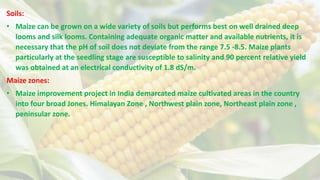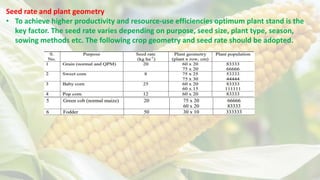Maize is a highly adaptable crop cultivated globally, known as the 'queen of cereals' due to its genetic yield potential, contributing significantly to grain production. The USA is the leading producer, while India has diverse cultivation practices across various states, with maize having a rich history of domestication and spread since ancient times. The document details maize's agricultural requirements, growth stages, types, and management practices necessary for optimal yield.


















![VARIETIES : DHM-101, 103, Rohini, Ashwini Trishulatha
Composites : Harsha & Varun :
For pure crop --- 20-25 kg seed/ha [60 x 25 cm or 75 x 20 cm]
For fodder maize --- 40-50 kg/ha
Crop geometry of 45x20 cm is found to be optimum for most of the areas.
Method of sowing :
• It is desirable to dibble the maize seed by the side of the ridges at a distance of 1/3 from the top
of the ridge.
• Dibble seed 2-3 cm deep and should not be more than 5 cm. Ridge sowing facilitated irrigation as
well as drainage](https://image.slidesharecdn.com/ram-2020-107maizeppt-220723022316-27797423/85/maize-crop-production-19-320.jpg)

![Pre emergence : of Simazine [Tafazine] or Atrazine [Atrafaf] at 2 kg/ha @ 2 or 3 DAS, is found to
control weeds effectively
• Later the soil should not be disturbed for 4-5 weeks herbicide.
Post emergence : of 2,4 DEE @ 1 ½ -2 kg/ha at when maize is about 20 cm ht.
WATER MANAGEMENT :
Maize is sensitive to both drought and water logging.
Maize uses water efficiently. Its water requirement is influenced by
1. growth stages
2. season
3. weather
4. Soil conditions](https://image.slidesharecdn.com/ram-2020-107maizeppt-220723022316-27797423/85/maize-crop-production-21-320.jpg)

